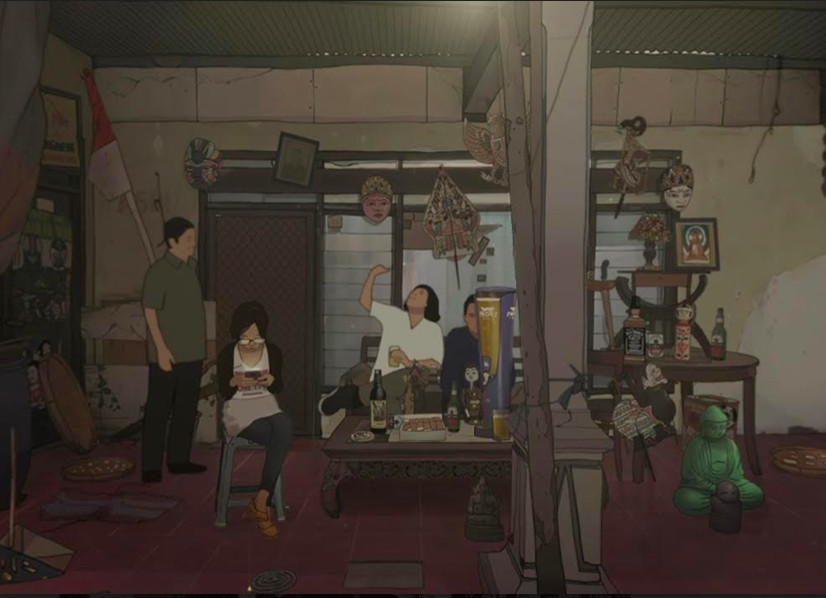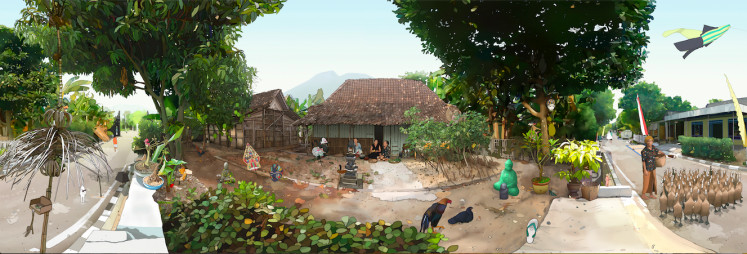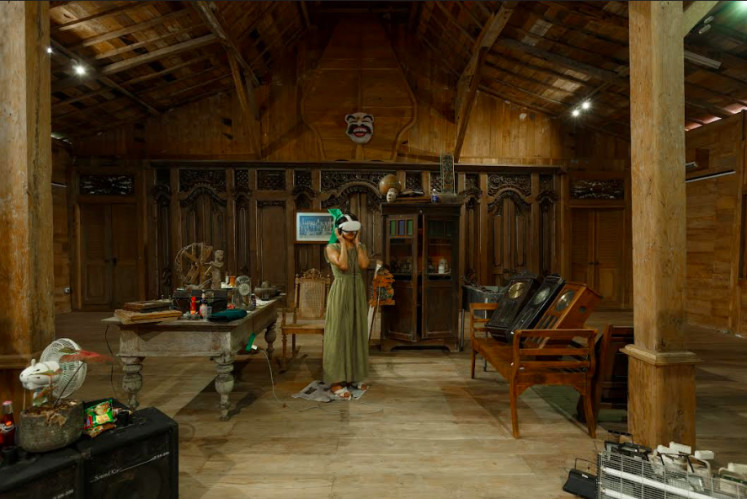Popular Reads
Top Results
Can't find what you're looking for?
View all search resultsPopular Reads
Top Results
Can't find what you're looking for?
View all search results'Replacements': a time-lapse VR journey from a Javanese village to a dystopian megacity
Change text size
Gift Premium Articles
to Anyone
F
rench-Indonesian illustrator and director Jonathan Hagard’s award-winning collaboration with Japanese animators is a fascinating, yet poignant experience depicting the multi-faceted modern transition and the futility of the capitalist centralized urban model.
Virtual reality (VR) transforms digital storytelling and introduces contemporary art to exciting new frontiers. The immersive experience, via head-mounted displays, headphones and sometimes hand controls, persuades our brains that we are situated elsewhere, transporting us to a new virtual location. VR is increasingly entering the 21st century modern experience. Utilized in video gaming, it is the fundamental platform of the metaverse -- the interactive future of the internet. Yet, until recently, VR has been an unexplored territory within Indonesian art.
Indonesia’s first VR artwork, “Replacements”, is a 360 degree happening locating the viewer in the center of the simulation. Within 12 minutes, via stylized imagery, we transition from 1980 to 2020. The video begins in a tranquil village. A timber dwelling in a spacious front yard then gives way to a concrete family home. Adults sit casually in conversation; the gentle twitter of birds from nearby trees greets us. Our eyes scan around, identifying familiar cultural and daily items. Then, turning our heads, the village scenario and the vast blue sky unfolds. For the novice yet to experience VR, the initial isolation from the real world, except for gravitational forces, may be confronting.
The view unfolds from traditional warung to small stores to the modern mini-mart. Trees disappear as overhead, power lines and condominiums materialize. Advertising becomes ubiquitous, and an overhead freeway appears. Seasonal rains flood the area, yet the deluges have become greater and increasingly littered over the years. Politics blasts from loudspeakers. Skyscrapers rise up from the haze, dwarfing us in perspective. A giant mosque manifests as do images of political leaders. Many icons of Java's rich traditions and heritage dissolve with modernization's chaos. The swift urban, environmental, political and cultural transformation grounds us within the harsh reality of the so-called "Muslim megacities."
A video still: A panoramic view of the beginning of "Replacements", by Jonathan Hagard. (Courtesy of Jonathan Hagard) (Courtesy of Jonathan Hagard/Courtesy of Jonathan Hagard)“Completed in early 2020, “Replacements” is based upon archive research, fiction, personal experience and the memories of the Central Javanese village where my mother was raised. The focal dwelling is my grandmother’s house. Her words, 'Remember your roots to understand your future', are my driving inspiration,” Hagard told The Jakarta Post. “My first VR venture, “Replacements”, required three years of work, including two years of intense production. This video follows Time Lapse, a short film I made in 2008, with a similar narrative.”
Hagard’s compelling animation premiered in Indonesia during Domesticity IX, his solo exhibition that closed on May 15 at Kayu located at the House of Masks and Puppets Setia Darma in Ubud, Bali. Hagard was invited to exhibit by the international art project Lucie Fontaine, which has previously presented events in Prague; Stockholm; Miami and New York, the United States; and the Bali artist-in-residency program Project Etere.
Do not miss out on the fun: A member of the public watches the VR animation "Replacements" by Jonathan Hagard during 'Domesticity IX Exhibition View'. (Courtesy of Jonathan Hagard and Kayu Lucie Fontaine) (Courtesy of Jonathan Hagard and Kayu Lucie Fontaine/Courtesy of Jonathan Hagard and Kayu Lucie Fontaine)Kayu is a feature of Italian Bali-based Marco Cassani’s artistic and curatorial practice. He creates social sculptures in the form of exhibitions and performances, collaborating with Indonesian and international artists. The ongoing decade-long series at Kayu entitled Domesticity deals with the relationship -- or lack thereof -- between contemporary art and domestic spaces. Kayu has evolved into one of the most interesting art spaces in Indonesia. It offers the Bali art scene a unique and alternative artist-run space to establish new ways of working with artists and displaying works of art.
“Replacements” was presented online at the Venice International Film Festival in September 2021. The festival coordinated a network of galleries worldwide for others to experience it in VR venues in France, the US, China and Taiwan. As a result, viewers realize that what is happening in their country is also happening elsewhere. Along with being honored in Japan, Germany and the US it was awarded the Cristal of the Best VR in the Annecy International Animation Film Festival in France. A locally specific narrative, “Replacements’” themes are globally significant.
“The story has such complexity and differing layers of lecture (interpretation); it requires something immersive to be understood and accepted because it talks about sensitive issues. Making it in conventional film would not have been adequate. I then realized that a 360 degree configuration would be perfect for the story. Initially, I was reluctant to adopt VR. Yet, in the middle of production, I decided it was the obvious format,” said Hagard, born in 1986 near Paris and currently residing in Kyoto, Japan.
A video still: A panoramic view of the beginning of "Replacements", by Jonathan Hagard. (Courtesy of Jonathan Hagard) (Courtesy of Jonathan Hagard/Courtesy of Jonathan Hagard)One of the video’s most confronting scenarios is an encounter with two children dressed in religious attire. Gazing into the depths of our being, they silently communicate that we are the problem, yet also the solution. “I faced many technical and story-telling challenges that had to be resolved during the process. Yet, I was happily surprised by the connection between the characters and myself upon first viewing the video,” said Hagard, who tells stories based on his experiences in megacities such as Tokyo and Jakarta. “I created characters to directly engage with the audience. So momentarily, we build emotional relationships with them. We can feel this in VR, but not within the medium of conventional film.”
“It is essential to remember our heritage in the digital age and in the post-reality-era transition we are enduring,” he stated.
Within Hagard’s cultural and generational essay, human consciousness informs itself through its creations. He shows us a mirror: this is where we come from and where we are going. He describes the Arabization of Java yet makes no judgments, allowing the audience to make up their own minds. Hagard’s dystopian masterwork confirms that we can avoid reality, but we cannot avoid the effects.













